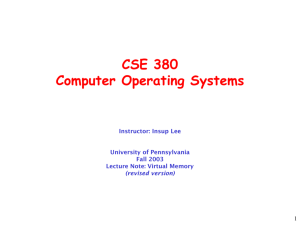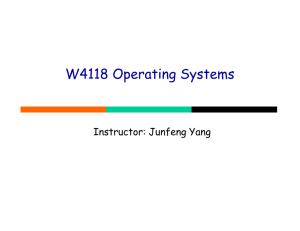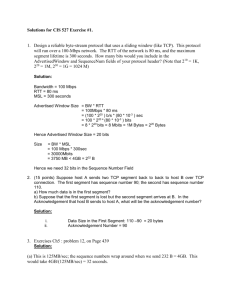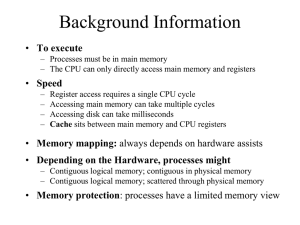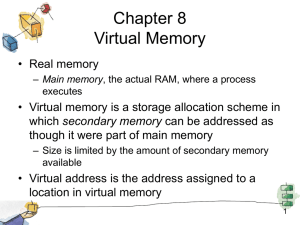Virtual Memory - University of Pennsylvania
advertisement
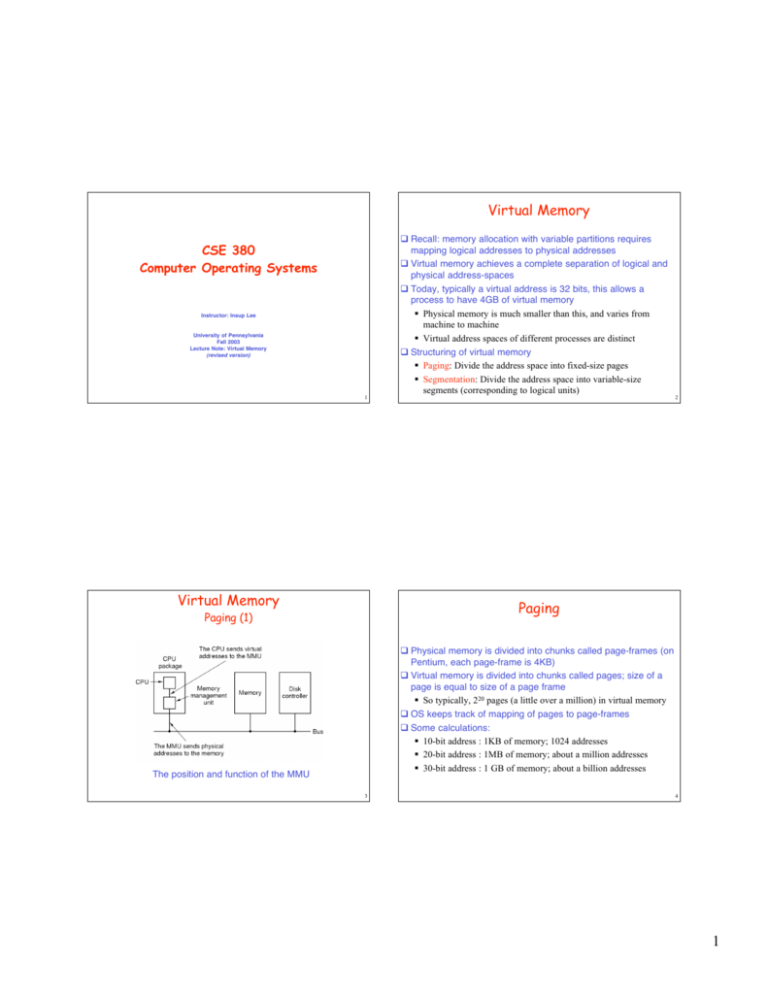
Virtual Memory
CSE 380
Computer Operating Systems
Instructor: Insup Lee
University of Pennsylvania
Fall 2003
Lecture Note: Virtual Memory
(revised version)
1
Virtual Memory
Recall: memory allocation with variable partitions requires
mapping logical addresses to physical addresses
Virtual memory achieves a complete separation of logical and
physical address-spaces
Today, typically a virtual address is 32 bits, this allows a
process to have 4GB of virtual memory
Physical memory is much smaller than this, and varies from
machine to machine
Virtual address spaces of different processes are distinct
Structuring of virtual memory
Paging: Divide the address space into fixed-size pages
Segmentation: Divide the address space into variable-size
segments (corresponding to logical units)
2
Paging
Paging (1)
Physical memory is divided into chunks called page-frames (on
Pentium, each page-frame is 4KB)
Virtual memory is divided into chunks called pages; size of a
page is equal to size of a page frame
So typically, 220 pages (a little over a million) in virtual memory
OS keeps track of mapping of pages to page-frames
Some calculations:
10-bit address : 1KB of memory; 1024 addresses
20-bit address : 1MB of memory; about a million addresses
30-bit address : 1 GB of memory; about a billion addresses
The position and function of the MMU
3
4
1
Paging (2)
Virtual Memory in Unix
Process B
The relation between
virtual addresses
and physical
memory addresses given by
page table
Process A
Virtual space
Virtual space
5
Paging
6
Page Table Entry
A virtual address is considered as a pair (p,o)
Low-order bits give an offset o within the page
High-order bits specify the page p
E.g. If each page is 1KB and virtual address is 16 bits, then
low-order 10 bits give the offset and high-order 6 bits give
the page number
The job of the Memory Management Unit (MMU) is to
translate the page number p to a frame number f
The physical address is then (f,o), and this is what goes on the
memory bus
For every process, there is a page-table (basically, an array),
and page-number p is used as an index into this array for
the translation
1. Validity bit: Set to 0 if the corresponding page is not in
memory
2. Frame number
Number of bits required depends on size of physical memory
3. Protection bits:
Read, write, execute accesses
4. Referenced bit is set to 1 by hardware when the page is
accessed: used by page replacement policy
5. Modified bit (dirty bit) set to 1 by hardware on write-access:
used to avoid writing when swapped out
7
8
2
Design Issues
Page Tables (1)
What is the “optimal” size of a page frame ?
Typically 1KB – 4KB, but more on this later
How to save space required to store the page table
With 20-bit page address, there are over a million pages, so the
page-table is an array with over million entries
Solns: Two-level page tables, TLBs (Translation Lookaside
Beffers), Inverted page tables
What if the desired page is not currently in memory?
This is called a page fault, and it traps to kernel
Page daemon runs periodically to ensure that there is enough
free memory so that a page can be loaded from disk upon a
page fault
Page replacement policy: how to free memory?
Internal operation of MMU with 16 4 KB pages
9
Multi-Level Paging
10
Paging in Linux
Keeping a page-table with
entries in memory is not viable
Solution: Make the page table hierarchical
Pentium supports two-level paging
Suppose first 10-bits index into a top-level page-entry table T1 (1024 or 1K
entries)
Each entry in T1 points to another, second-level, page table with 1K
entries (4 MB of memory since each page is 4KB)
Next 10-bits of physical address index into the second-level page-table
selected by the first 10-bits
Total of 1K potential second-level tables, but many are likely to be unused
If a process uses 16 MB virtual memory then it will have only 4 entries in
top-level table (rest will be marked unused) and only 4 second-level tables
220
Linux uses three-level page tables
11
12
3
Translation Lookaside Buffer (TLB)
More on TLB
Protection bits
Page-tables are in main memory
Access to main memory is slow compared to clock cycle on
CPU (10ns vs 1 ns)
An instruction such as MOVE REG, ADDR has to decode
ADDR and thus go through page tables
This is way too slow !!
Standard practice: Use TLB stored on CPU to map pages
to page-frames
TLB stores small number (say, 64) of page-table entries to
avoid the usual page-table lookup
TLB is associative memory and contains, basically, pairs of
the form (page-no, page-frame)
Special hardware compares incoming page-no in parallel
with all entries in TLB to retrieve page-frame
If no match found in TLB, standard look-up invoked
Frame number
Page number
Modified bit
Key design issue: how to improve hit rate for TLB?
Which pages should be in TLB: most recently accessed
Who should update TLB?
Modern architectures provide sophisticated hardware support
to do this
Alternative: TLB miss generates a fault and invokes OS,
which then decides how to use the TLB entries effectively.
13
14
Inverted Page Tables
Hashed Page Tables
When virtual memory is much larger than physical
memory, overhead of storing page-table is high
For example, in 64-bit machine with 4KB per page and
256 MB memory, there are 64K page-frames but 252
pages !
Solution: Inverted page tables that store entries of the
form (page-frame, process-id, page-no)
At most 64K entries required!
Given a page p of process x, how to find the
corresponding page frame?
Linear search is too slow, so use hashing
Note: issues like hash-collisions must be handled
Used in some IBM and HP workstations; will be used
more with 64-bit machines
Page number
Offset
PID
Hash
PID Page
#
15
Frame #
Hash table
Number of entries: Number of page frames
16
4
Steps in Paging
Page Fault Handling
Today’s typical systems use TLBs and multi-level paging
Paging requires special hardware support
Overview of steps
1. Input to MMU: virtual address = (page p, offset o)
2. Check if there is a frame f with (p,f) in TLB
3. If so, physical address is (f,o)
4. If not, lookup page-table in main memory ( a couple of
accesses due to multi-level paging)
5. If page is present, compute physical address
6. If not, trap to kernel to process page-fault
7. Update TLB/page-table entries (e.g. Modified bit)
Hardware traps to kernel on page fault
CPU registers of current process are saved
OS determines which virtual page needed
OS checks validity of address, protection status
Check if there is a free frame, else invoke page replacement
policy to select a frame
If selected frame is dirty, write it to disk
When page frame is clean, schedule I/O to read in page
Page table updated
Process causing fault rescheduled
Instruction causing fault reinstated (this may be tricky!)
Registers restored, and program continues execution
17
Paging Summary
Page Replacement Algorithms
When should a page be replaced
Upon a page fault if there are no page frames available
By pager daemon executed periodically
Pager daemon needs to keep free page-frames
Executes periodically (e.g. every 250 msec in Unix)
If number of free page frames is below certain fraction (a
settable parameter), then decides to free space
Modified pages must first be saved
unmodified just overwritten
Better not to choose an often used page
will probably need to be brought back in soon
Well-understood, practical algorithms
Useful in other contexts also (e.g. web caching)
How long will access to a location in page p take?
If the address of the corresponding frame is found in TLB?
If the page-entry corresponding to the page is valid?
18
Using two-level page table
Using Inverted hashed page-table
If a page fault occurs?
How to save space required to store a page table?
Two-level page-tables exploit the fact only a small and
contiguous fraction of virtual space is used in practice
Inverted page-tables exploit the fact that the number of valid
page-table entries is bounded by the available memory
Note: Page-table for a process is stored in user space
19
20
5
Reference String
Forward and backward distances
Def: The forward distance for page X at time t,
denoted by dt(X), is
Def: The virtual space of a process consists of N = {1,2,…,n}
pages.
A process reference string w is the sequence of pages referenced
by a process for a given input:
w = r1 r2 … rk … rT
where rk ∈ N is the page referenced on the k th memory
reference.
dt(X) = k
rt+k.
if the first occurrence of X in r t+1 rt+2 …at
dt(X) = ∞ if X does not appear in rt+1 rt+2 ….
E.g., N = {0,...,5}.
w=003455522212221100
Def: The backward distance for page X at time t,
denoted by bt(X), is
bt(X) = k if rt-k was the last occurrence of X.
Given f page frames,
• warm-start behavior of the replacement policy
• cold-start behavior of the replacement policy
bt(X) = ∞ if X does not appear in r1 r2 … rt-1.
21
Paging Replacement Algorithms
22
Optimal Page Replacement Algorithm
If we knew the precise sequence of requests for pages, we
can optimize for least number of faults
1 Random -- Worst implementable method, easy to implement.
2 FIFO - Replace the longest resident page. Easy to implement since
control information is a FIFO list of pages.
Consider a program with 5 pages and
reference string
w = 1 2 3 4 1 2 5 1 2 3 4 5
Suppose there are 3 page frames.
w = 1 2 3 4 1 2 5 1 2 3 4 5
------------------------------------PF 1
1 1 1 4 4 4 5 5 5 5 5 5
PF 2
2 2 2 1 1 1 1 1 3 3 3
PF 3
3 3 3 2 2 2 2 2 4 4
-------------------------------------victim
1 2 3 4
1 2
Replace page needed at the farthest point in future
Optimal but unrealizable
Off-line simulations can estimate the performance of this
algorithm, and be used to measure how well the chosen
scheme is doing
Competitive ratio of an algorithm = (page-faults generated by
optimal policy)/(actual page faults)
Consider reference string: 1 2 3 4 1 2 5 1 2 3 2 5
23
24
6
First Attempts
Consider a program with 5 pages and
reference string
w = 1 2 3 4 1 2 5 1 2 3 4 5
Suppose there are 3 page frames.
PF 1
PF 2
PF 3
victim
Use reference bit and modified bit in page-table entry
Both bits are initially 0
Read sets reference to 1, write sets both bits to 1
Reference bit cleared on every clock interrupt (40ms)
w = 1 2 3 4 1 2 5 1 2 3 4 5
Prefer to replace pages unused in last clock cycle
First, prefer to keep pages with reference bit set to 1
Then, prefer to keep pages with modified bit set to 1
Easy to implement, but needs additional strategy to resolve ties
Note: Upon a clock interrupt, OS updates CPU-usage counters for
scheduling in PCB as well as reference bits in page tables
25
Queue Based Algorithms
26
Second Chance Page Replacement
FIFO
Maintain a linked list of pages in memory in order of arrival
Replace first page in queue
Easy to implement, but access info not used at all
Modifications
Second-chance
Clock algorithm
Pages ordered in a FIFO queue as before
If the page at front of queue (i.e. oldest page) has Reference
bit set, then just put it at end of the queue with R=0, and try
again
Effectively, finds the oldest page with R=0, (or the first one in
the original queue if all have R=1)
Easy to implement, but slow !!
1
1
A
B
0
1
D
C
0
E
After Page Replacement (C is replaced)
0
1
D
27
E
0
A
0
B
0
Free
28
7
Clock Algorithm
Least Recently Used (LRU)
Optimization of Second chance
Keep a circular list with current pointer
If current page has R=0 then replace, else set R to 0 and
move current pointer
1
0
C
0
0
B
E
B
1
D
A
1
0
E
This is the best method that is implementable since the past is
usually a good indicator for the future.
It requires enormous hardware assistance: either a fine-grain
timestamp for each memory access placed in the page table,
or a sorted list of pages in the order of references.
0
Current
A
Assume pages used recently will be used again soon
throw out page that has been unused for longest time
Consider the following references assuming 3 frames
1 2 3 4 1 2 5 1 2 3 2 5
1
D
0
Free
Current
29
How to implement LRU?
30
Approximating LRU: Aging
Bookkeeping on every memory access is expensive
Software solution: OS does this on every clock interrupt
Every page-entry has an additional 8-bit counter
Every clock cycle, for every page in memory, shift the
counter 1 bit to the right copying R bit into the high-order bit
of the counter, and clear R bit
On page-fault, or when pager daemon wants to free up
space, pick the page with lowest counter value
Intuition: High-order bits of recently accessed pages are set
to 1 (i-th high-order bit tells us if page was accessed during ith previous clock-cycle)
Potential problem: Insufficient info to resolve ties
Only one bit info per clock cycle (typically 40ms)
Info about accesses more than 8 cycles ago lost
Main challenge: How to implement this?
Reference bit not enough
Highly specialized hardware required
Counter-based solution
Maintain a counter that gets incremented with each memory
access,
Copy the counter in appropriate page table entry
On page-fault pick the page with lowest counter
List based solution
Maintain a linked list of pages in memory
On every memory access, move the accessed page to end
Pick the front page on page fault
31
32
8
Analysis of Paging Algorithms
Aging Illustration
Reference string r for a process is the sequence of pages
referenced by the process
Suppose there are m frames available for the process, and
consider a page replacement algorithm A
We will assume demand paging, that is, a page is brought in only
upon fault
Let F(r,m,A) be the faults generated by A
Belady’s anomaly: allocating more frames may increase the
faults: F(r,m,A) may be smaller than F(r,m+1,A)
Worth noting that in spite of decades of research
Worst-case performance of all algorithms is pretty bad
Increase m is a better way to reduce faults than improving A
(provided we are using a stack algorithm)
Clock tick
0
0
1
1
0
0
1
1
Accessed in previous 8th clock cycle?
Accessed in last clock cycle?
Update upon clock interrupt
R
0
1
0
0
1
0
1
R bit of current cycle
33
Effect of replacement policy
34
Belady’s Anomaly
For FIFO algorithm, as the following counter-example shows,
increasing m from 3 to 4 increases faults
Evaluate a page replacement policy by observing how it
behaves on a given page-reference string.
w | 1 2 3 4 1 2 5 1 2 3 4 5
------------------------------| 1 2 3 4 1 2 5 5 5 3 4 4
m=3 |
1 2 3 4 1 2 2 2 5 3 3
|
1 2 3 4 1 1 1 2 5 5
----------------------------| 1 2 3 4 4 4 5 1 2 3 4 5
m=4 |
1 2 3 3 3 4 5 1 2 3 4
|
1 2 2 2 3 4 5 1 2 3
|
1 1 1 2 3 4 5 1 2
Page faults
No. of page frames
35
9 page
faults
10 page
faults
36
9
Thrashing
Stack Algorithms
Will the CPU Utilization increase monotonically as the degree
Of multiprogramming (number of processes in memory) increases?
For an algorithm A, reference string r , and page-frames m, let
P(r,m,A) be the set of pages that will be in memory if we run A
on references r using m frames
An algorithm A is called a stack algorithm if for all r and for all
m, P(r,m,A) is a subset of P(r,m+1,A)
Intuitively, this means the set of pages that A considers relevant
grows monotonically as more memory becomes available
For stack algorithms, for all r and for all m, F(r,m+1,A) cannot
be more than F(r,m,A) (so increasing memory can only reduce
faults!)
LRU is a stack algorithm: P(r,m,LRU) should be the last m
pages in r, so P(r,m,LRU) is a subset of P(r,m+1,LRU)
Not really! It increases for a while, and then starts dropping again.
Reason: With many processes around, each one has only a few pages in memory,
so more frequent page faults, more I/O wait, less CPU utilization
CPU
util.
|
|
|
|
|
|
-------------------degree of
multiprogramming
Bottomline: Cause of low CPU utilization is either too few or too many processes!
37
38
Locality
Locality of Reference
To avoid thrashing (i.e. too many page faults), a process
needs “enough” pages in the memory
Memory accesses by a program are not spread all over its
virtual memory randomly, but show a pattern
E.g. while executing a procedure, a program is accessing the
page that contains the code of the procedure, the local variables,
and global vars
This is called locality of reference
How to exploit locality?
Prepaging: when a process is brought into memory by the
swapper, a few pages are loaded in a priori (note: demand
paging means that a page is brought in only when needed)
Working set: Try to keep currently used pages in memory
The phenomenon that programs actually use only a limited set
of pages during any particular time period of execution.
This set of pages is called the locality of the program during that
time.
Ex. Program phase diagram
virtual
^
address
|-------------------------5|
|
| x | x |
|
|-------------------------4|
|
| x | x |
|
|-------------------------segments 3|
| x | x | x | x |
|-------------------------2| x | x |
| x | x |
|-------------------------1| x | x |
|
|
|
|-------------------------->
1
2
3
4
5 virtual
phases
time
39
40
10
Working Set
Working Set
Working set of a process at time t is the set of pages
referenced over last k accesses (here, k is a parameter)
Goal of working set based algorithms: keep the working set in
memory, and replace pages not in the working set
Maintaining the precise working set not feasible (since we
don’t want to update data structures upon every memory
access)
Compromise: Redefine working set to be the set of pages
referenced over last m clock cycles
Recall: clock interrupt happens every 40 ms and OS can check if
the page has been referenced during the last cycle (R=1)
Complication: what if a process hasn’t been scheduled for a
while? Shouldn’t “over last m clock cycles” mean “over last m
clock cycles allotted to this process”?
The working set of a process is the set of all pages accessed by
the process within some fixed time window.
Locality of reference means that a process's working set is
usually small compared to the total number of pages it
possesses.
A program's working set at the k-th reference with window size h
is defined to be
W(k,h) = { i ∈ N | page i appears among rk-h+1 … rk }
The working set at time t is
W(t,h) = W(k,h) where time(rk) ≤ t < t(rk+1)
Ex. h=4
w = 1
2 3 4 1 2 5 1 2 5 3 2
| | | | | | | | | | | |
{1} | | | | | | | | | | |
{1,2}| {1,2,3,4} | {1,2,5} | |
{1,2,3}
{1,2,4,5}
{1,2,3,5}
41
Virtual Time and Working Set
42
WSClock Replacement Algorithm
Each process maintains a virtual time in its PCB entry
This counter should maintain the number of clock cycles that
the process has been scheduled
Each page table entry maintains time of last use (wrt to the
process’s virtual time)
Upon every clock interrupt, if current process is P, then
increment virtual time of P, and for all pages of P in memory,
if R = 1, update “time of last use” field of the page to current
virtual time of P
Age of a page p of P = Current virtual time of P minus time of
last use of p
If age is larger than some threshold, then the page is not in
the working set, and should be evicted
Combines working set with clock algorithm
Each page table entry maintains modified bit M
Each page table entry maintains reference bit R indicating
whether used in the current clock cycle
Each PCB entry maintains virtual time of the process
Each page table entry maintains time of last use
List of active pages of a process are maintained in a ring with
a current pointer
43
44
11
WSClock Algorithm
WSClock Algorithm
Maintain reference bit R and dirty bit M for each page
Maintain process virtual time in each PCB entry
Maintain Time of last use for each page (age=virtual time – this field)
To free up a page-frame, do:
Examine page pointed by Current pointer
If R = 0 and Age > Working set window k and M = 0 then add this page to
list of free frames
If R = 0 and M = 1 and Age > k then schedule a disk write, advance current,
and repeat
If R = 1or Age <= k then clear R, advance current, and repeat
If current makes a complete circle then
If some write has been scheduled then keep advancing current till some
write is completed
If no write has been scheduled then all pages are in working set so pick a
page at random (or apply alternative strategies)
Current Virtual Time = 32
Threshold for working set = 10
Last use
M R
30 0 1
31 0 0
E
Last use
M R
30 0 0
Current
A
Current
A
25 1 0
B
25 1 0
31 0 0
B
E
20 0 0
D
18 1 0
C
0
18 1 0
0 0
C
Free
Write to disk Scheduled
45
Page Replacement in Unix
46
UNIX and Swapping
Under normal circumstances pager daemon keeps enough pages free to
avoid thrashing. However, when the page daemon is not keeping up with
the demand for free pages on the system, more drastic measures need
be taken: swapper swaps out entire processes
Unix uses a background process called paging daemon that
tries to maintain a pool of free clean page-frames
Every 250ms it checks if at least 25% (a adjustable
parameter) frames are free
selects pages to evict using the replacement algorithm
Schedules disk writes for dirty pages
The swapper typically swaps out large, sleeping processes in order to
free memory quickly. The choice of which process to swap out is a
function of process priority and how long process has been in main
memory. Sometimes ready processes are swapped out (but not until
they've been in memory for at least 2 seconds).
Two-handed clock algorithm for page replacement
Front hand clears R bits and schedules disk writes (if needed)
Page pointed to by back hand replaced (if R=0 and M=0)
The swapper is also responsible for swapping in ready-to-run but
swapped-out processes (checked every few seconds)
47
48
12
Local Vs Global Policy
PFF (page Fault Frequency)
direct way to control page faults.
|
|
page |- - - - - - - - - - - upper bound
fault|
(increase # of frames)
rate |
|
|- - - - - - - - - - - lower bound
|
(decrease # of frames)
|
---------------------# of frames
Paging algorithm can be applied either
1 locally: the memory is partitioned into “workspace”, one for each
process.
(a) equal allocation: if m frames and n processes then m/n frames.
(b) proportional allocation: if m frames & n processes, let s i be the size
of Pi.
n
S = ∑i =1 si
ai = si / S × m
2 globally: the algorithm is applied to the entire collection of running
programs. Susceptible to thrashing (a collapse of performance due
to excessive page faults).
Thrashing directly related to the degree of multiprogramming.
Program restructuring
to improve locality
at compile-time
at run-time
(using information saved during exec)
49
Data structure on page faults
50
What’s a good page size ?
OS has to determine the size of a page
Does it have to be same as size of a page frame (which is
determined by hardware)? Not quite!
Arguments for smaller page size:
Less internal fragmentation (unused space within pages)
Can match better with locality of reference
Arguments for larger page size
Less number of pages, and hence, smaller page table
Less page faults
Less overhead in reading/writing of pages
int a[128][128]
for (j=0, j<128, j++)
for (i=0, i<128, i++)
a[i,j]=0
for (i=0, i<128, i++)
for (j=0, j<128, j++)
a[i,j]=0
C row first
FORTRAN column first
51
52
13
Page Size
Thm. (Optimal Page Size)
(wrt factors 1 & 2)
Let c1 = cost of losing a word to table fragmentation and c2 =
cost of losing a word to internal fragmentation.
Assume that each program begins on a page boundary.
If the avg program size s0 is much larger than the page size z,
then the optimal page size z0 is approximately √2cs0 where c =
c1 /c2.
Proof.
1 (to reduce) table fragmentation ⇒ larger page
2 internal fragmentation ⇒ smaller page
3 read/write i/o overhead for pages ⇒ larger page
4 (to match) program locality (& therefore to reduce total
i/o) ⇒ smaller page
5 number of page faults ⇒ larger page
int. frag. cos t = c2 z / 2
tablefrag. cos t = c1 s0 / z
E [cos t | z ] = c1 s0 / z + c2 z / 2
dE / ez = − c1 s0 / z 2 + c2 / 2
0 = − c1 s0 / z 2 + c2 / 2
c1 s0 = c2 z 2 / 2
2c1 / c2 s0 = z 2
z =
2c1 / c2 s0
53
54
Page size examples
c1=c2=1
z
8
16
32
64
128
256
512
1024
s0
32
128
512
2K
8K
32K
128K
Page Size: Tradeoff
f=z/s0× 100%
512K
25
13
6
3
1.6
.8
.4
Overhead due to page table and internal fragmentation
2sepoverheadp⋅=+page table space
where
.2
s = average process size in bytes
p = page size in bytes
e = page entry
c1 > c2⇒ larger page than above (need cache)
c1 < c2 (unlikely) ⇒smaller
GE645
64 word & 1024 word pages
IBM/370
2K & 4K
VAX
512bytes
Berkeley Unix 2 x 512 = 1024
internal
fragmentation
Optimized
2pse= when
If s = 4 MB, and e = 8B, then p = 8 KB
55
56
14
Sharing of Pages
Shared Pages with separate page tables
Can two processes share pages (e.g. for program text)
Solution in PDP-11:
Use separate address space and separate page table for
instructions (I space) and data (D space)
Two programs can share same page tables in I space
Alternative: different entries can point to the same page
Careful management of access writes and page replacement
needed
In most versions of Unix, upon fork, parent and child use same
pages but have different page table entries
Pages initially are read-only
When someone wants to write, traps to kernel, then OS copies the
page and changes it to read-write (copy on write)
Process table
g
Q
P
f
Frame f, read
Frame g, read
Frame f, read
Frame g, read
Memory
Page table for Q
Page table for P
Two processes sharing same pages with “copy on write”
57
Implementation without Paging
Segmentation
Recall: Paging allows mapping of virtual addresses to
physical addresses and is transparent to user or to
processes
Orthogonal concept: Logical address space is partitioned
into logically separate blocks (e.g. data vs code) by the
process (or by the compiler) itself
Logical memory divided into segments, each segment has a
size (limit)
Logical address is (segment number, offset within seg)
Note: Segmentation can be with/without virtual memory and
paging
Conceptual similarity to threads: threads is a logical
organization within a process for improving CPU usage,
segments are for improving memory usage
58
Segment Table
+------------+
0 |
10, 8
|
+------------+
5
1 |
30, 5
|
+------------+
10
2 | not present|
+------------+
3 |
5, 5
|
+------------+
| illeg. seg |
+------------+
30
Physical Memory
+------------+
|
|
+------------+
|
seg 3
| First few bits of
+------------+
|
seg 0
| address give segment
|
|
+------------+
|
|
|
|
|
|
+------------+
Segment table keeps
|
seg 1
|
Base, Limit
35 +------------+
|
|
|
|
+------------+
59
logical address
physical address
0,2
------>
12
1,4
------>
34
0,9
------> illegal offset
2,1
------>
absent seg.
60
15
Advantages
Segmentation with Paging
Address allocation is easy for compiler
Different segments can grow/shrink independently
Natural for linking separately compiled code without
worrying about relocation of virtual addresses
Just allocate different segments to different packages
Application specific
Large arrays in scientific computing can be given their own
segment (array bounds checking redundant)
Natural for sharing libraries
Different segments can have different access protections
Code segment can be read-only
Different segments can be managed differently
Address space within a segment can be virtual, and
managed using page tables
Same reasons as we saw for non-segmented virtual memory
Two examples
Multics
Pentium
Steps in address translation
1. Check TLB for fast look-up
2. Consult segment table to locate segment descriptor for s
3. Page-table lookup to locate the page frame (or page fault)
61
Multics: Segmentation+ Paging
Segment #
18 bits
s
Page # Offset
10 bits
6 bits
p
Multics Memory
Physical address: (f,o)
o
Base + 218
b06+p Valid Frame number f
base +s base addr b
base
At most 64
Length l
Check p <= l
Segment Table
b06
62
34-bit address split into 18-bit segment no, and 16 bit
(virtual) address within the segment
Thus, each segment has 64K words of virtual memory
Physical memory address is 24 bits, and each page frame
is of size 1K
Address within segment is divided into 6-bit page number
and 10-bit offset
Segment table has potentially 256K entries
Each segment entry points to page table that contains upto
64 entries
Page Table for segment s
63
64
16
Multics details cont
Pentium
16K segments divided into LDT and GDT (Local/Global
Descriptor Tables)
Segment selector: 16 bits
1 bit saying local or global
2 bits giving protection level
13 bits giving segment number
Special registers on CPU to select code segment, data
segment etc
Incoming address: (selector,offset)
Selector is added to base address of segment table to
locate segment descriptor
Phase 1: Use the descriptor to get a “linear” address
Limit check
Add Offset to base address of segment
Segment table entry is 36 bits consisting of
main memory address of page table (but only 18 bits needed,
last 6 bits assumed to be 0)
Length of segment (in terms of number of pages, this can be
used for a limit check)
Protection bits
More details
Different segments can have pages of different sizes
Segment table itself can be in a segment itself (and can be
paged!)
Memory access first has to deal with segment table and
then with page table before getting the frame
TLBs absolutely essential to make this work!
65
66
Paging in Pentium
Paging can be disabled for a segment
Linear virtual address is 32 bits, and each page is 4KB
Offset within page is 12 bits, and page number is 20 bits.
Thus, 220 pages, So use 2-level paging
Each process has page directory with 1K entries
Each page directory entry points to a second-level page
table, in turn with 1K entries (so one top-level entry can
cover 4MB of memory)
TLB used
Many details are relevant to compatibility with earlier
architectures
67
17
